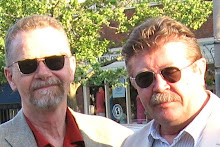
THEATRE REVIEW:
TOMBS OF THE VANISHING INDIAN
11 MAR/11
JOHN COULBOURN - QMI Agency
Rating: 3.5 out of 5
Of all the ways mankind has found to victimize his fellow man, genocide is perhaps the most enduring, revisiting its victims with the birth (or lack of it) of every subsequent generation. For proof, look to research conducted by a Native American museum in California, which showed that 94% of its clientele came to see a people that no longer existed.
That it was a vanished people patrons were coming to see and not a vanishing way of life spoke volumes to playwright Marie Clements, who was thus challenged to examine in microcosm some of the ways in which North America’s indigenous population has been systematically reduced to a point where too many people believe it not longer exists at all. Her play is called TOMBS OF THE VANISHING INDIAN and it had its world première Thursday, a joint presentation of Native Earth Performing Arts and red diva projects, at Buddies in Bad Times.
Set in and around Los Angeles toward the middle of the last century, it tells the tragic story of three Native sisters, brought to the coast by a loving mother in search of a better life for her children. Instead, she finds a society that thinks it knows, far better than she, how to give those children that better life — and the three sisters suddenly find themselves orphaned and alone, wards of a system that sees them as problems rather than as people.
The diminutive Michelle St. John looms large as the tragic mother whose passion and presence haunts the entire show, while Nicole Joy-Fraser, Falen Johnson and PJ Prudat play her three daughters, Jessie, Miranda and Janey.
The eldest, Jessie, has been ‘disappeared’ most conventionally, adopted by a loving white family who kept her far removed from her Native heritage, from her sisters and from Los Angeles itself. A few decades on, she returns with her new husband (Keith Barker), determined to put their newly minted medical credentials to use by helping the poor. As for her two sisters, Jessie has no idea if they are still alive, or that they have endured an horrific round of abusive foster homes, residential schools and religion, each of which has served to separate them from their own people without making them part of another. But the worst horror has been visited on them at the very clinic in which their eldest sister now labours — a crime that comes to light only when Jessie is found bloodied and alone and is questioned, lost as she is in the memory of her people, by a sympathetic detective (Martin Julien) who suspects she has killed her baby. Similarly abused, Miranda finds her way into acting, where she falls victim to a tortured filmmaker (David Storch) who sees her merely as a childhood fantasy made flesh, robbing her too of the last tattered vestiges of her heritage.
Clements’ script covers a lot of turf and makes a lot of demands on cast and director in the course of 90 minutes, careering between the pragmatic and the poetic, the deeply tragic and the subversively funny. And while director Yvette Nolan, working on a beautiful albeit fussy set created by Jackie Chau and lit by Michelle Ramsay, focuses her cast to meet all of those demands, she struggles and sometimes loses her way in the transitions between a world where memory and spirit dwell, and the world of reality.
Still, in the story it tells, and the larger issues on which it focuses our attention, TOMBS OF THE VANISHING INDIAN is often deeply touching, a piece of theatrical anthropology about the determined survival of a people - not its demise.




No comments:
Post a Comment